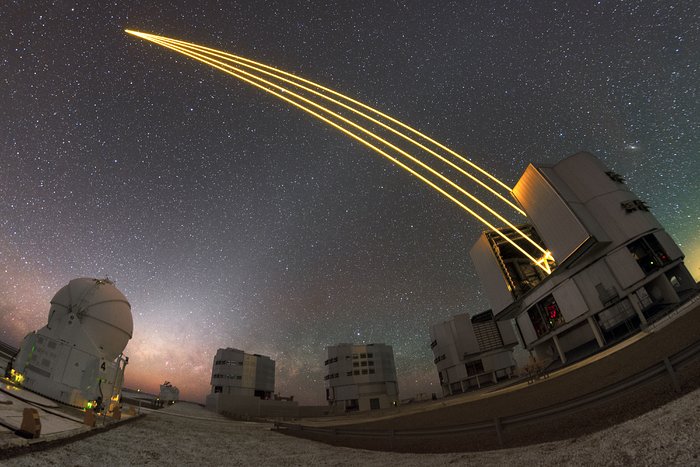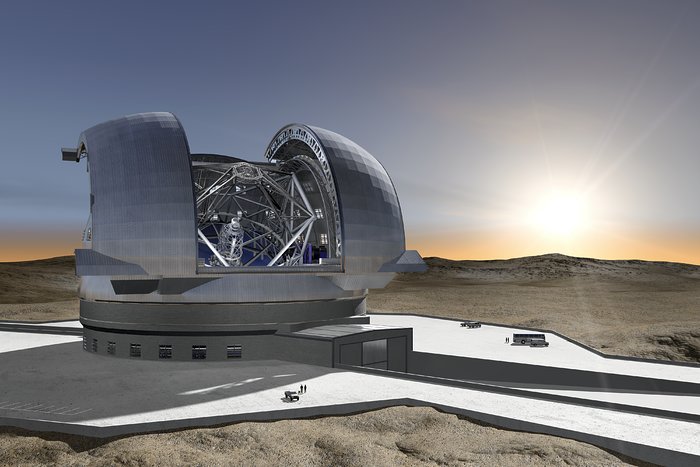Stardust and Eternity – 3.5.2
Professional On-Ground Instrumentation
Professional astronomers learn about physical and chemical properties of stars, planets, and galaxies by studying the radiation emitted by these objects. This electromagnetic radiation must first be collected by suitable instruments and then processed before it can be analysed and converted into useful knowledge. Telescopes are the appropriate devices for collecting and focusing the electromagnetic radiation of astronomical objects. Optical telescopes fall into two categories: refracting telescopes, which use lenses, and reflecting telescopes, which use mirrors.
Refracting telescopes have two major shortcomings. First, there are physical limits to their size: larger telescopes are heavier, which implies technological limits to their construction. Secondly, they suffer from chromatic aberration – i.e. the white light from the celestial sources tends to be dispersed in its spectral colours, as the shorter (bluer) wavelengths are refracted more strongly than the longer (redder) ones, producing unwanted halos (although a lens composed of two types of glass can partially compensate for chromatic aberration).
Reflecting telescopes suffer from less shortcomings, so much that their primary mirrors continue to grow, becoming larger every decade. Indeed, the mirrors can be supported from the back and made thinner and less massive than the lenses of refracting telescopes. The “size” of a telescope properly refers to the diameter (or “aperture”) of the largest mirror or lens in the instrument. The light-collecting power of a telescope is proportional to the area of its aperture (the square of its diameter), so the larger the aperture, the more light the telescope can gather (the aperture of the human eye is about 7 mm, but the diameters of optical telescopes can reach up to several metres). Another important characteristic of a telescope is its resolution, i.e. its ability to separate two images that appear close together: increasing the focal length increases the size and separation between the images that a telescope produces. The focal length of a human eye is about 2 cm, while professional telescopes often have focal lengths of tens or even hundreds of metres, allowing much more detail to be obtained.
Larger telescopes have better resolution and can distinguish objects that appear closer, but for telescopes with apertures larger than about one metre, Earth’s atmosphere creates problems. This problem is called turbulence, the same effect that causes stars to twinkle at night: when a telescope placed on the ground looks at a star, the light it captures has first travelled through air into the atmosphere. If that air is turbulent, the light is blurred. The limit to the resolution of a telescope on Earth caused by this atmospheric distortion is called “astronomical seeing”. Modern technology has improved ground-based telescopes with computer-controlled adaptive optics that compensate for much of the atmosphere’s distortion, a technique that allows to sharpen blurry images just as they are being taken, using lasers, supercomputers, and an array of mirrors to correct for atmospheric distortion.
The location of the telescope is also an important factor. Astronomers look for sites located as high as possible, so that they are above a significant part of the Earth’s atmosphere; dry, dark sites away from city lights, where there is little humidity or rain and a relatively calm atmosphere. Many telescopes are therefore located on remote, high peaks surrounded by desert or ocean. Today, thousands of ground-based telescopes operate around the globe. The world’s largest optical telescope – still under construction in a high and arid region of the Atacama Desert in northern Chile – is the 39-meter European Extremely Large Telescope (E-ELT). This telescope will allow us to study Earth-sized planets around star systems, the first galaxies in the universe, supermassive black holes, and to find water and organic molecules in outer space. Once completed, it will collect 100 million times more light than the human eye; furthermore, it will be able to correct for atmospheric distortion thanks to adaptive optics and it will provide images 16 times sharper than those of the Hubble Space Telescope. Its construction should be completed around 2027. Compared to space-based telescopes, ground-based telescopes can be built larger and at a lower cost. Moreover, they are easier to maintain and upgrade, having a much lower risk of being damaged by one of the hundreds of thousands of debris flying through the cosmos – or space junk. Ground-based telescopes, however, are not able to detect frequencies and wavelengths across the entire electromagnetic spectrum, as the Earth’s atmosphere absorbs much of the infrared and ultraviolet light that passes through it. Space telescopes are therefore needed to explore the sky across the entire electromagnetic spectrum.


Further Resources
Links below will redirect you to external websites. In accordance with the European data protection declarations, we would like to point out that by clicking on these links you may send data to external providers. We cannot prevent that.
Images
![]() Size comparison between telescope domes (ESO)
Size comparison between telescope domes (ESO)
![]() Size comparison between the E-ELT and other telescope mirrors (ESO)
Size comparison between the E-ELT and other telescope mirrors (ESO)
![]() The Extremely Large Telescope (ELT)
The Extremely Large Telescope (ELT)
![]() ELT and VLT vs Giza Pyramids (ESO)
ELT and VLT vs Giza Pyramids (ESO)
![]() The optical system of the ELT showing the location of the mirrors (ESO)
The optical system of the ELT showing the location of the mirrors (ESO)
![]() The Atacama Large Millimeter/submillimeter Array (ALMA) (ESO/B. Tafreshi)
The Atacama Large Millimeter/submillimeter Array (ALMA) (ESO/B. Tafreshi)
![]() Adaptive Optics explained (ESO)
Adaptive Optics explained (ESO)
![]() Neptune from the VLT with and without adaptive optics (ESO/P. Weilbacher (AIP)
Neptune from the VLT with and without adaptive optics (ESO/P. Weilbacher (AIP)
Videos
![]() The history of telescopes – From Galileo to Hubble
The history of telescopes – From Galileo to Hubble
![]() The Giant Magellan Telescope: 10x The Power of the Hubble
The Giant Magellan Telescope: 10x The Power of the Hubble
![]() The Future of The Most Powerful Mega-Telescopes
The Future of The Most Powerful Mega-Telescopes
 Caccia ai confini dello Spazio Documentario sulla storia dei telescopi (Focus)
Caccia ai confini dello Spazio Documentario sulla storia dei telescopi (Focus)
 Come fa un telescopio a osservare e ingrandire oggetti così lontani nello spazio? Ecco come funziona (Geopop)
Come fa un telescopio a osservare e ingrandire oggetti così lontani nello spazio? Ecco come funziona (Geopop)
 Giant Magellan Telescope, in Cile si inizia a costruire la struttura (MEDIAINAF TV)
Giant Magellan Telescope, in Cile si inizia a costruire la struttura (MEDIAINAF TV)
 I nuovi Super Telescopi del prossimo futuro documentario (Focus)
I nuovi Super Telescopi del prossimo futuro documentario (Focus)
Online Resources
 L’invenzione del telescopio: storia dello strumento con cui osserviamo l’universo (Geopop)
L’invenzione del telescopio: storia dello strumento con cui osserviamo l’universo (Geopop)
 La storia dei telescopi (Vultus)
La storia dei telescopi (Vultus)
Further Readings
![]() Galileo and 400 Years of Telescopic Astronomy (Peter Grego, David Mannion)
Galileo and 400 Years of Telescopic Astronomy (Peter Grego, David Mannion)
![]() Telescopes: A Very Short Introduction (Geoff Cottrell)
Telescopes: A Very Short Introduction (Geoff Cottrell)
![]() Eyes on the Universe: The Story of the Telescope (Patrick Moore)
Eyes on the Universe: The Story of the Telescope (Patrick Moore)
 Telescopi ottici, radio, X: principi e differenze (Valerio Oss)
Telescopi ottici, radio, X: principi e differenze (Valerio Oss)
Teaching Material
![]() Getting children into astronomy
Getting children into astronomy
For Kids
 Chi ha inventato il telescopio? (Focus Junior)
Chi ha inventato il telescopio? (Focus Junior)
